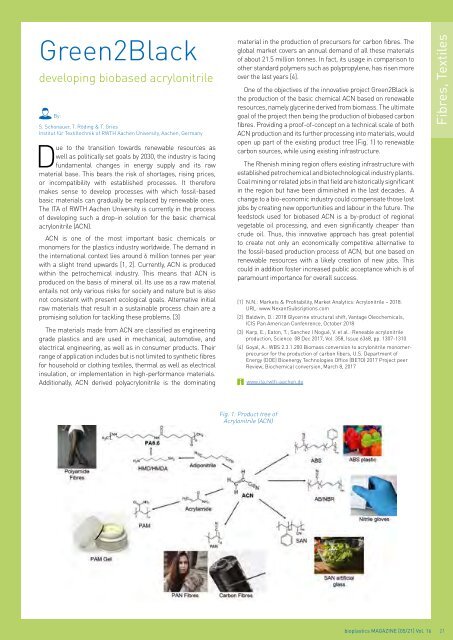issue 05/2021
Highlights: Fibres, Textiles, Nonwovens Biocomposites Basics: CO2-based plastics
Highlights:
Fibres, Textiles, Nonwovens
Biocomposites
Basics: CO2-based plastics
You also want an ePaper? Increase the reach of your titles
YUMPU automatically turns print PDFs into web optimized ePapers that Google loves.
Green2Black<br />
developing biobased acrylonitrile<br />
By:<br />
S. Schonauer, T. Röding & T. Gries<br />
Institut für Textiltechnik of RWTH Aachen University, Aachen, Germany<br />
Due to the transition towards renewable resources as<br />
well as politically set goals by 2030, the industry is facing<br />
fundamental changes in energy supply and its raw<br />
material base. This bears the risk of shortages, rising prices,<br />
or incompatibility with established processes. It therefore<br />
makes sense to develop processes with which fossil-based<br />
basic materials can gradually be replaced by renewable ones.<br />
The ITA of RWTH Aachen University is currently in the process<br />
of developing such a drop-in solution for the basic chemical<br />
acrylonitrile (ACN).<br />
ACN is one of the most important basic chemicals or<br />
monomers for the plastics industry worldwide. The demand in<br />
the international context lies around 6 million tonnes per year<br />
with a slight trend upwards [1, 2]. Currently, ACN is produced<br />
within the petrochemical industry. This means that ACN is<br />
produced on the basis of mineral oil. Its use as a raw material<br />
entails not only various risks for society and nature but is also<br />
not consistent with present ecological goals. Alternative initial<br />
raw materials that result in a sustainable process chain are a<br />
promising solution for tackling these problems. [3]<br />
The materials made from ACN are classified as engineering<br />
grade plastics and are used in mechanical, automotive, and<br />
electrical engineering, as well as in consumer products. Their<br />
range of application includes but is not limited to synthetic fibres<br />
for household or clothing textiles, thermal as well as electrical<br />
insulation, or implementation in high-performance materials.<br />
Additionally, ACN derived polyacrylonitrile is the dominating<br />
material in the production of precursors for carbon fibres. The<br />
global market covers an annual demand of all these materials<br />
of about 21.5 million tonnes. In fact, its usage in comparison to<br />
other standard polymers such as polypropylene, has risen more<br />
over the last years [4].<br />
One of the objectives of the innovative project Green2Black is<br />
the production of the basic chemical ACN based on renewable<br />
resources, namely glycerine derived from biomass. The ultimate<br />
goal of the project then being the production of biobased carbon<br />
fibres. Providing a proof-of-concept on a technical scale of both<br />
ACN production and its further processing into materials, would<br />
open up part of the existing product tree (Fig. 1) to renewable<br />
carbon sources, while using existing infrastructure.<br />
The Rhenish mining region offers existing infrastructure with<br />
established petrochemical and biotechnological industry plants.<br />
Coal mining or related jobs in that field are historically significant<br />
in the region but have been diminished in the last decades. A<br />
change to a bio-economic industry could compensate those lost<br />
jobs by creating new opportunities and labour in the future. The<br />
feedstock used for biobased ACN is a by-product of regional<br />
vegetable oil processing, and even significantly cheaper than<br />
crude oil. Thus, this innovative approach has great potential<br />
to create not only an economically competitive alternative to<br />
the fossil-based production process of ACN, but one based on<br />
renewable resources with a likely creation of new jobs. This<br />
could in addition foster increased public acceptance which is of<br />
paramount importance for overall success.<br />
[1] N.N.: Markets & Profitability, Market Analytics: Acrylonitrile – 2018.<br />
URL: www.NexantSubsriptions.com<br />
[2] Baldwin, D.: 2018 Glycerine structural shift, Vantage Oleochemicals,<br />
ICIS Pan American Confenrence, October 2018<br />
[3] Karp, E.; Eaton, T.; Sanchez I Nogué, V. et al.: Reneable acrylonitrile<br />
production, Science 08 Dec 2017, Vol. 358, Issue 6368, pp. 1307-1310<br />
[4] Goyal, A.: WBS 2.3.1.200 Biomass conversion to acrylonitrile monomerprecursor<br />
for the production of carbon fibers, U.S. Department of<br />
Energy (DOE) Bioenergy Technologies Office (BETO) 2017 Project peer<br />
Review, Biochemical conversion, March 8, 2017<br />
www.ita.rwth-aachen.de<br />
Fibres, Textiles textiles<br />
Fig. 1: Product tree of<br />
Acrylonitrile (ACN)<br />
bioplastics MAGAZINE [<strong>05</strong>/21] Vol. 16 21

















